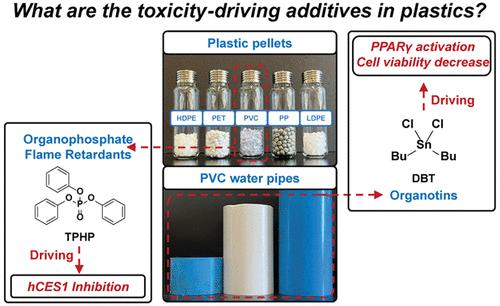当前位置:
X-MOL 学术
›
Environ. Sci. Technol.
›
论文详情
Our official English website, www.x-mol.net, welcomes your
feedback! (Note: you will need to create a separate account there.)
Defining the Chemical Additives Driving In Vitro Toxicities of Plastics
Environmental Science & Technology ( IF 10.8 ) Pub Date : 2022-09-29 , DOI: 10.1021/acs.est.2c03608 Wanzhen Chen 1 , Yufeng Gong 1 , Michael McKie 2 , Husein Almuhtaram 2 , Jianxian Sun 1 , Holly Barrett 1 , Diwen Yang 1 , Menghong Wu 2 , Robert C Andrews 2 , Hui Peng 1, 3
Environmental Science & Technology ( IF 10.8 ) Pub Date : 2022-09-29 , DOI: 10.1021/acs.est.2c03608 Wanzhen Chen 1 , Yufeng Gong 1 , Michael McKie 2 , Husein Almuhtaram 2 , Jianxian Sun 1 , Holly Barrett 1 , Diwen Yang 1 , Menghong Wu 2 , Robert C Andrews 2 , Hui Peng 1, 3
Affiliation

|
Increases in the global use of plastics have caused concerns regarding potential adverse effects on human health. Plastic products contain hundreds of potentially toxic chemical additives, yet the exact chemicals which drive toxicity currently remain unknown. In this study, we employed nontargeted analysis and in vitro bioassays to identify the toxicity drivers in plastics. A total of 56 chemical additives were tentatively identified in five commonly used plastic polymer pellets (i.e., PP, LDPE, HDPE, PET, and PVC) by employing suspect screening and nontargeted analysis. Phthalates and organophosphates were found to be dominant in PVC pellets. Triphenyl phosphate and 2-ethylhexyl diphenyl phosphate accounted for a high amount (53.6%) of the inhibition effect of PVC pellet extract on human carboxylesterase 1 (hCES1) activity. Inspired by the high abundances of chemical additives in PVC pellets, six different end-user PVC-based products including three widely used PVC water pipes were further examined. Among them, extracts of PVC pipe exerted the strongest PPARγ activity and cell viability suppression. Organotins were identified as the primary drivers to these in vitro toxicities induced by the PVC pipe extracts. This study clearly delineates specific chemical additives responsible for hCES1 inhibition, PPARγ activity, and cell viability suppression associated with plastic.
中文翻译:

定义导致塑料体外毒性的化学添加剂
全球塑料使用量的增加引起了人们对对人类健康潜在不利影响的担忧。塑料产品含有数百种可能有毒的化学添加剂,但目前尚不清楚导致毒性的确切化学物质。在这项研究中,我们采用非靶向分析和体外生物测定以确定塑料中的毒性驱动因素。通过可疑筛选和非靶向分析,初步确定了五种常用塑料聚合物颗粒(即PP、LDPE、HDPE、PET和PVC)中的56种化学添加剂。发现邻苯二甲酸盐和有机磷酸盐在 PVC 颗粒中占主导地位。磷酸三苯酯和磷酸 2-乙基己基二苯酯占 PVC 颗粒提取物对人羧酸酯酶 1 (hCES1) 活性的抑制作用的大部分 (53.6%)。受 PVC 颗粒中大量化学添加剂的启发,进一步研究了六种不同的最终用户基于 PVC 的产品,包括三种广泛使用的 PVC 水管。其中,PVC管提取物的PPARγ活性和细胞活力抑制作用最强。有机锡被确定为这些的主要驱动因素PVC管提取物引起的体外毒性。该研究清楚地描述了与塑料相关的 hCES1 抑制、PPARγ 活性和细胞活力抑制的特定化学添加剂。
更新日期:2022-09-29
中文翻译:

定义导致塑料体外毒性的化学添加剂
全球塑料使用量的增加引起了人们对对人类健康潜在不利影响的担忧。塑料产品含有数百种可能有毒的化学添加剂,但目前尚不清楚导致毒性的确切化学物质。在这项研究中,我们采用非靶向分析和体外生物测定以确定塑料中的毒性驱动因素。通过可疑筛选和非靶向分析,初步确定了五种常用塑料聚合物颗粒(即PP、LDPE、HDPE、PET和PVC)中的56种化学添加剂。发现邻苯二甲酸盐和有机磷酸盐在 PVC 颗粒中占主导地位。磷酸三苯酯和磷酸 2-乙基己基二苯酯占 PVC 颗粒提取物对人羧酸酯酶 1 (hCES1) 活性的抑制作用的大部分 (53.6%)。受 PVC 颗粒中大量化学添加剂的启发,进一步研究了六种不同的最终用户基于 PVC 的产品,包括三种广泛使用的 PVC 水管。其中,PVC管提取物的PPARγ活性和细胞活力抑制作用最强。有机锡被确定为这些的主要驱动因素PVC管提取物引起的体外毒性。该研究清楚地描述了与塑料相关的 hCES1 抑制、PPARγ 活性和细胞活力抑制的特定化学添加剂。









































 京公网安备 11010802027423号
京公网安备 11010802027423号